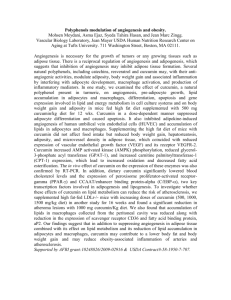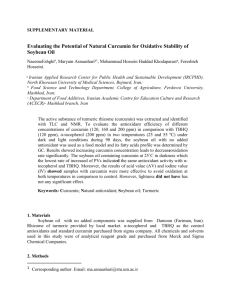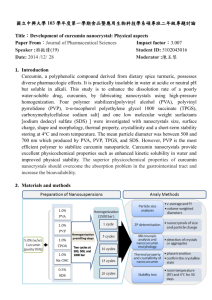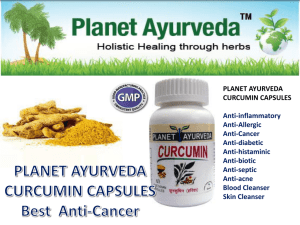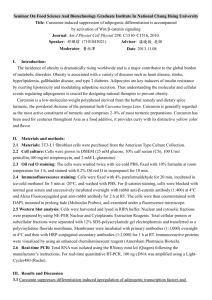Salindong Courtney Salindong Final Portfolio: Illumin Article Writing
advertisement
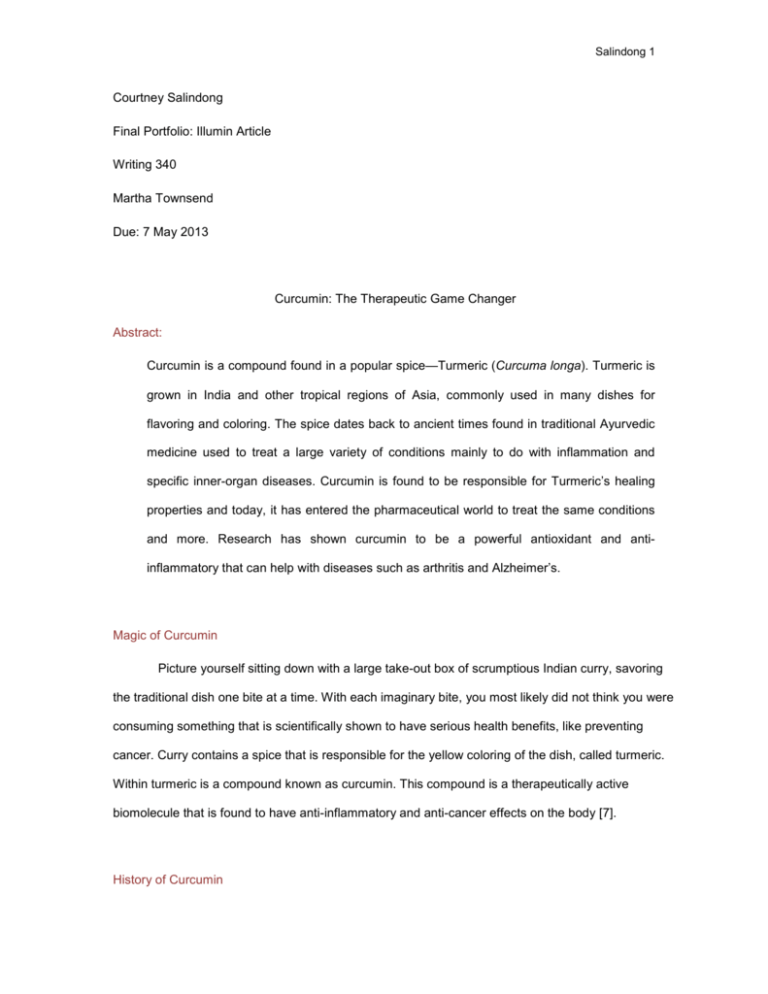
Salindong 1 Courtney Salindong Final Portfolio: Illumin Article Writing 340 Martha Townsend Due: 7 May 2013 Curcumin: The Therapeutic Game Changer Abstract: Curcumin is a compound found in a popular spice—Turmeric (Curcuma longa). Turmeric is grown in India and other tropical regions of Asia, commonly used in many dishes for flavoring and coloring. The spice dates back to ancient times found in traditional Ayurvedic medicine used to treat a large variety of conditions mainly to do with inflammation and specific inner-organ diseases. Curcumin is found to be responsible for Turmeric’s healing properties and today, it has entered the pharmaceutical world to treat the same conditions and more. Research has shown curcumin to be a powerful antioxidant and antiinflammatory that can help with diseases such as arthritis and Alzheimer’s. Magic of Curcumin Picture yourself sitting down with a large take-out box of scrumptious Indian curry, savoring the traditional dish one bite at a time. With each imaginary bite, you most likely did not think you were consuming something that is scientifically shown to have serious health benefits, like preventing cancer. Curry contains a spice that is responsible for the yellow coloring of the dish, called turmeric. Within turmeric is a compound known as curcumin. This compound is a therapeutically active biomolecule that is found to have anti-inflammatory and anti-cancer effects on the body [7]. History of Curcumin Salindong 2 Turmeric is an herb (Curcuma longa) belonging to the ginger family [1]. It was originally cultivated as a dye and has since been used for dietary and cosmetic purposes. Not long after it was first cultivated, was it discovered that the spice had various healing properties. Medicinal uses for this spice can be traced back to as early as the seventh century AD [4]. Records of the use of turmeric can be found in ancient Ayurveda, which is the Indian system of holistic medicine. Some of the conditions turmeric treated includes stomach pain, fever, bronchitis, and bladder and kidney inflammations [4]. The spice was also applied topically to help with bruises, leech bites, eye infections, mouth inflammations, and infected wounds [4]. This powerful plant not only served as a food spice to people of Southeast Asia and western India, but it also was a multipurpose healing agent for common ailments. Researchers found the healing properties of turmeric belonged to its inner compound curcumin. This compound was first isolated in 1815 by Vogel and Pelletier, two Harvard college laboratory scientists [12]. It was not until 1910 that its chemical structure was found, and its anti inflammatory properties were being recognized in the medical field. For a period of time, however, advancements in modern medicine caused most natural, plant-derived medicine to decrease due to technological ease in isolating and synthesizing versions of natural drugs. But over the last two decades, researchers have also found some natural products, including curcumin, to be nontoxic or have less toxicity than the synthetic versions, which would be ideal for people with cancer whose immune systems are especially sensitive. This characteristic sparked an interest to re-investigate natural products as chemopreventive agents [1]. How Curcumin Works Curcumin as a dietary supplement has several benefits. It serves as an antioxidant, which is a substance that protects good cells from damaging. It also reduces chronic inflammation within the body as well as decreases the number of cancer cells. Curcumin does this by directly working inside Salindong 3 our cells. During processes of cell replication and protein production, a DNA sequence has to be transcribed and translated. DNA is thought of as the ultimate set of recipes each cell ever needs to have during its lifetime to produce specific proteins that make up our body [2]. How this works is that an enzyme will transcribe DNA, the transcription will form RNA, and RNA will then be translated into amino acids, which are the building blocks of a protein [2]. However, sometimes there’s a kink in the protein making process and a toxic protein is produced. When a bad protein is produced it can then trigger chronic inflammation and negative cell-growth. Figure 1. Drawing of inside cell and close up of DNA Source: Illustration by Courtney Salindong Curcumin helps cells carry out the transcription and translation process properly. Curcumin works by preventing harmful cell growth and treating existing damaging cells. Its job is to inhibit various gene-regulators that promote malignant tumor formation, inflammation, cell survival, and cell invasion [1]. By blocking these harmful regulators, curcumin prevents bad cells from growing and multiplying, therefore helping to prevent the birth of cancer cells. To better understand what it does within a cell, imagine a security detector in the airport filtering out the dangerous items that could potentially hurt people. The detector identifies harmful objects and stops them from entering an area, keeping the airport and its people safe. Curcumin performs in a similar manner. It identifies certain regulators that can produce a harmful effect on the body and stops it from signaling the gene to form or produce more in the body. Inflammation is stopped by curcumin inhibiting certain enzymes that cause the swelling, such as the nuclear factor-κB enzyme [1]. Curcumin helps prevent cancer in the same way. It blocks the cell-growth cycle in cancer cells, which reduces the number of mutations. Therefore, it is less likely for a malignant cell to form or even metastasize. Early signs show curcumin Salindong 4 can also improve cognitive function in the elderly. Because of curcumin’s inhibiting ability, it can suppress plaque burdens on the brain, which is the main cause for Alzheimer’s. Overall, curcumin functions as a security detector within our bodies—helping to fight off metastases promoting genes [1]. The Problem of Pure Curcumin Commercializing curcumin into a pharmaceutical faces one main obstacle: the bioavailability of the substance is low [4]. Bioavailability measures how much of the compound in a particular dose is able to enter in the blood stream in its pure form. Unaltered, the bioavailability of curcumin is poor because of its physical properties, which cause low absorption, and the body’s high metabolic rate [8]. Curcumin’s physical properties can be explained by its chemical structure. Due to the structure, the molecule is nonpolar which causes it to be hydrophobic, meaning it is not soluble in water. Because our body is mainly made up of water, it is hard for the compound to absorb into our system. Figure 2. Chemical Structure of Curcumin. Because of the structure is symmetrical, the electrons of each atom are distributed evenly, making the molecule non-polar. Source: Sigma Aldrich In addition, the body’s rate of metabolism is too fast. Before curcumin has the chance to enter the blood stream, it is broken down into sub compounds, which are called metabolites [10]. The breakdown occurs mainly in the liver where it undergoes two reactions: glucuronidation and sulfation [10]. From those two reactions curcumin is broken down into curcumin glucuronide and curcumin sulphate. Currently, it is unknown whether the effects of these metabolites are the same as curcumin. Because of this uncertainty, curcumin as a dietary supplement will be synthesized to prevent the breakdown as much as possible. Salindong 5 Figure 3. Metabolites of Curcumin. These are the chemical structures of the two main metabolites that curcumin breaks down into when it goes through the digestive process. Source: Illustration by Courtney Salindong, Chemical Structures [10] The Solution There are two common ways to increase the drug’s medicinal efficacy: preparing curcumin in a medium that is lipid based and adding another compound called peperine. The lipid based medium addresses curcumin’s insolubility in water, while peperine targets the body’s metabolic pathways. Research shows preparation in a lipid medium will allow curcumin to work better when interacting with the body, by acting as a delivery system for the molecule as it travels through the digestive pathway [10]. Adding a small amount of peperine can increase curcumin’s bioavailability by a significant amount as well. Peperine is another naturally found molecule that it is responsible for the pungent taste and smell of black pepper. Peperine inhibits the metabolic pathway of curcumin in the liver, allowing curcumin to disperse into other parts of the body in its pure form [4, 10]. Researchers are still looking for more ways to increase curcumin’s bioavailability. New procedures have surfaced and received attention, such as implementing nanoparticle technology, but they have not been studied fully to state results [10]. The lipid base medium and the addition of peperine remain as the two main solutions that are applied in today’s production of curcumin. The Future of Curcumin Salindong 6 The future of curcumin as a drug looks promising. The benefits seem revolutionary and this discovery puts us a step closer to figuring out more ways to prevent other cancers. Because testing of this compound is fairly new, the long-term effects are not well known. However, so far the long-term effects on the body look more safe than harmful. The research community’s overall stance on this substance is enthusiastic [1]. Researchers continue to study the inner workings of curcumin in order to synthesize future chemopreventive substances and hopefully one day cure cancer completely. For now, it continues to serve as a dietary supplement that helps prevent cancer and reduce chronic inflammation. References [1] Ajay Goel et al. "Curcumin as "Curecumin": From kitchen to clinic." Biochemical Pharmacology, pp. 787-809, 2007. [2] Alberts B et al. “Molecular Biology of the Cell.” New York: Garland Science. 4th edition, 2002. [3] Amanda Chan. “Curcumin and 8 Other Foods and Factors That May Lower Diabetes Risk.” The Huffington Post, July 31, 2012. [4] American Cancer Society. “Tumeric.” December 07, 2012. [5] Chris Kilham. “Shop Smart: Turmeric and Curcumin.” Better Nutrition, September 2010. Salindong 7 [6] Huadong Tang et al. “Curcumin polymers as anticancer conjugates.” Biomaterials, Vol. 31, pp. 7139-7149, June 29, 2010. [7] Jack Challem. “Curcumin.” Better Nutrition, Vol. 69, Issue 10, pp. 30, Oct. 2007. [8] National Cancer Institute. “Antioxidants and Cancer Prevention: Fact Sheet.” July 28, 2004. [9] Owen D. Vincent. “Natural Chemopreventive Therapy: Curcumin.” Osteopathic Family Physician, Vol. 3, Issue 2, pp. 74-76, April 2011. [10] Preetha Anand et al. “Bioavailability of Curcumin: Problems and Promises.” Molecular Pharmaceutics. Vol. 4 (6), pp. 807-818, 2007. [11] R.A. Sharma et al. “Curcumin: The Story so Far.” European Journal of Cancer, Vol. 41, pp. 1955-1968, August 2, 2005. [12] Sowmya Nath. “Spicy Approach to Cancer Treatment.” JNCI News. Vol. 123, Issue 6, pp. 1817, Dec. 2011.
